The Nursing Madonna in the Middle Ages: An Interdisciplinary Study
Abstract
1. Introduction
These are also called “womanish things” (muliebria), for the woman is the only menstruating animal. If touched by the blood of the menses, crops cease to sprout, unfermented wine turns sour, plants wither, trees lose their fruit, iron is corrupted by rust, bronze turns black. If dogs eat any of it, they are made wild with rabies. The glue of pitch, which is dissolved neither by iron not water, when polluted with this blood spontaneously disperses2.(Isid. orig. XI, 140–41; Barney et al. 2006, p. 240)
1.1. Objectives of the Study
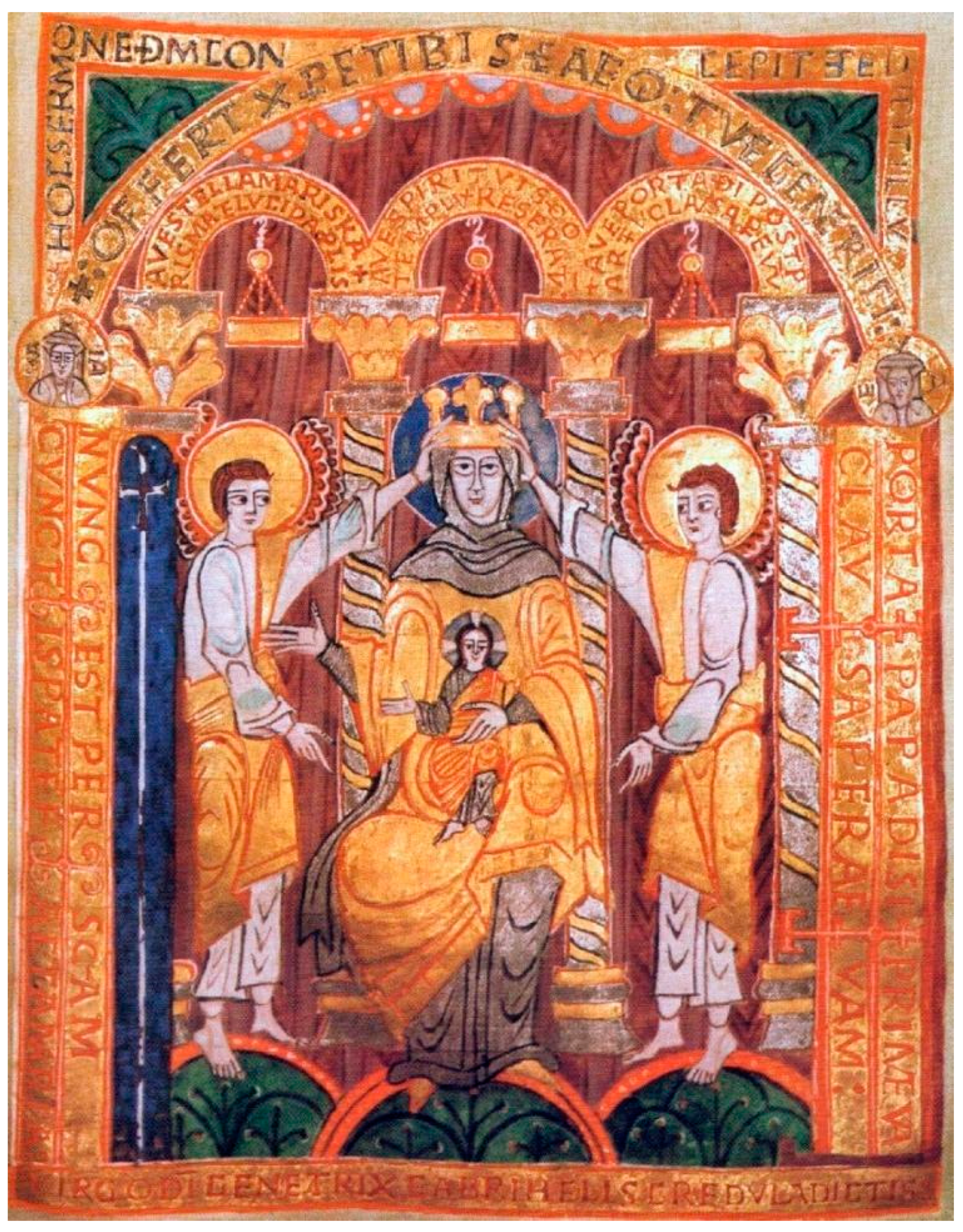
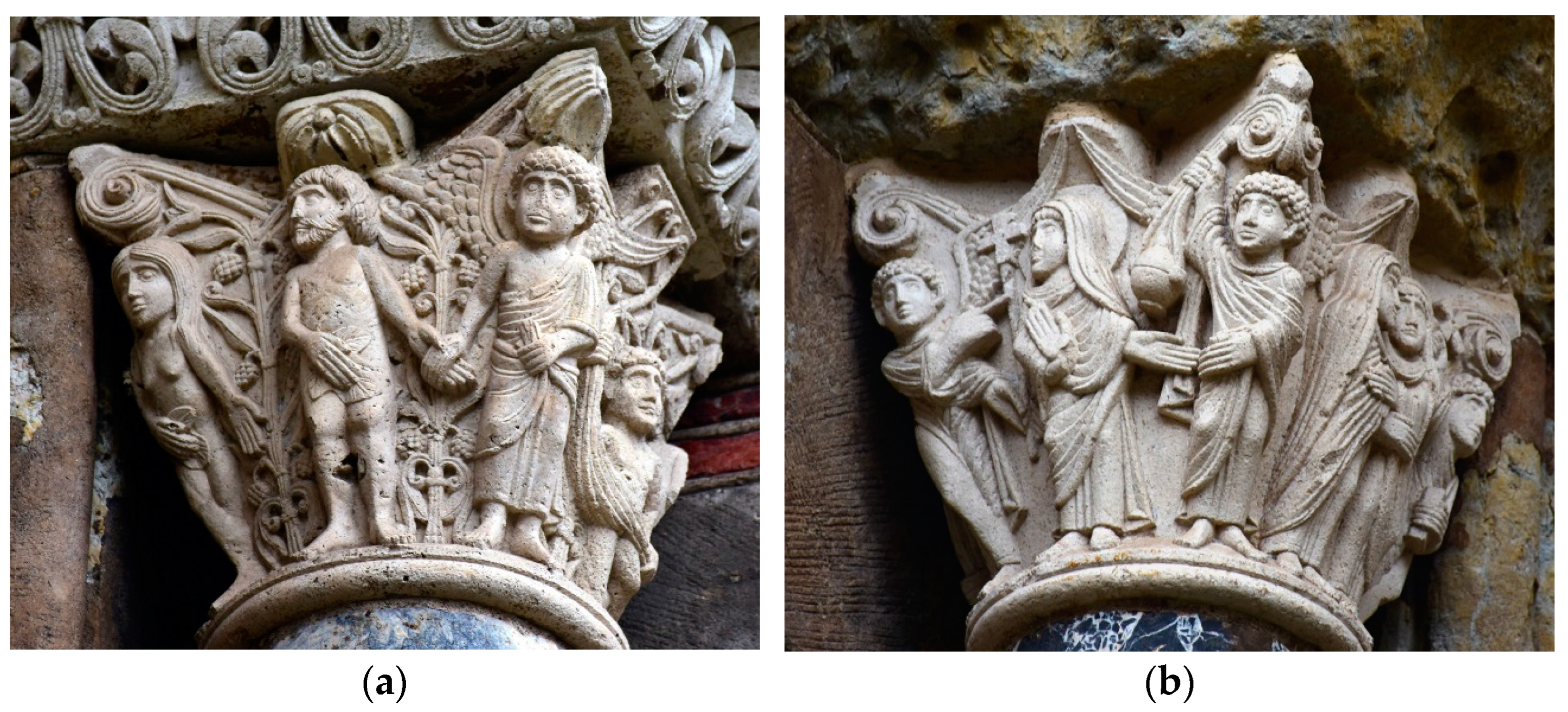
1.2. Brief State of Research
2. Motherhood as a Punishment for the Original Sin
If there dwelt upon earth a faith as great as is the reward of faith which is expected in the heavens, no one of you at all, best beloved sisters, from the time that she had first “known the Lord,” and learned (the truth) concerning her own (that is, woman’s) condition, would have desired too gladsome (not to say too ostentatious) a style of dress; so as not rather to go about in humble garb, and rather to affect meanness of appearance, walking about as Eve mourning and repentant, in order that by every garb of penitence she might the more fully expiate that which she derives from Eve,—the ignominy, I mean, of the first sin, and the odium (attaching to her as the cause) of human perdition4.(Tert. cult. fem. I, 1, l. 1; CPL, 11)
Augustine says (Serm. de Nativ.), addressing himself to the Virgin-Mother: “In conceiving thou wast all pure, in giving birth thou wast without pain.” (…) as Augustine says (Serm. de Assumpt. B. Virg.), from this sentence we must exclude the Virgin-Mother of God; who, “because she conceived Christ without the defilement of sin, and without the stain of sexual mingling, therefore did she bring Him forth without pain, without violation of her virginal integrity, without detriment to the purity of her maidenhood.”6.(Summa Theologica, Part III, Question 35, Article 6)
3. The (Nursing) Madonna as the New Eve
Joseph looked far away and saw a woman coming from a distance (…) And as the two went together, Joseph asked her on the way and said: “Woman, tell me your name that I may know who you are.” The woman said: “Why are you asking me? I am Eve, the foremother of all, and I have come to behold with my own eyes the redemption that is wrought on my behalf.” (…) they boved down and fell prostrate, and raising their voices they blessed God saying: “Blessed are you, Lord God of Israel, who today wrought salvation to the children of men by your coming.” (Eve added): “And you restored me from that fall and established (me) in my former glory. (…) And the foremother entered the cave and took the infant into her lap, hugged him tenderly and kissed him and blessed God. (…) When the foremother came out of that cave, she suddenly met a woman who was coming from the city of Jerusalem whose name was Salome.” The foremother approached her and said to her: “I bring you recent good news: a virgin who had never known a man gave birth to a male child.”.(8:9–9:3; Terian 2008, pp. 43–45)
4. Breastfeeding in Sacred Images
4.1. The Virgin of Humility: Another Iconographical Type of the Nursing Madonna
4.2. Breastfeeding in Religious Sources
4.3. Breastfeeding in Medical Sources: Lactation and Chastity
Christ, then, may be symbolized both as a bee and as the flower springing from the rod. And, as we know, the rod is the Virgin Mother of God. This flower, the Son of the Virgin, is “white and ruddy, chosen out of thousands.” It is the flower on which the angels desire to look, the flower whose perfume shall revive the dead, the flower, as He Himself declares, of the field, not of the garden. This flower grew and flourished in the field independent of all human culture; unsown by the hand of man, untilled by the spade, or fattened by moisture. So did the womb of Mary blossom. As a rich pasture it brought forth the flower of eternal beauty, whose freshness shall never fade nor see corruption, whose glory is to everlasting. O sublime virgin rod, that raisest thy holy head aloft, even to Him Who sitteth on the throne, even to the Lord of Majesty! And this is not wonderful, for thou hast planted thy roots deeply in the soil of humility. O truly celestial plant, than which none more precious, none more holy!(Sermones de Tempore. In Adventu Domini. Sermo II, 4; PL 183, 42; Bernard of Clairvaux 1909, pp. 17–18)17
[…] the mother, in the child she engenders, puts only part of her blood, from which the male’s virtue, shaping it, makes flesh and bones. The wet nurse that raises the child also provides the same, since milk is blood, and in that blood the same virtue from the father, who lives in the son, makes the same creation. But the difference is this: the mother provided her flow for nine months, and the wet nurse for twenty-four; and the mother did so during birth when the child was a trunk with no feelings at all, but the wet nurse did so when the child begins to feel and recognize the good he or she receives; the mother influences the body, the wet nurse the soul. Thus, taking proper stock, the wet nurse is the mother, and the one that gave birth to the child is worse than a stepmother, since she alienates the child from herself and makes a bastard of one that was born legitimately, and is the reason one who could have been noble is born badly; and in a way she commits a kind of adultery, a little less ugly and no less harmful than the ordinary kind. Because in one case the woman sells the husband a child that is not his; and in the other one that is not hers, making the successor the son of the wet nurse and of the lass, who is more often than not a villain or slave (345)19.
5. Milk as Eucharistic Fluid
6. Redeemed and “Sanctified” Eve
7. Conclusions
Funding
Acknowledgments
Conflicts of Interest
| 1 | CEV <https://www.biblegateway.com> (accessed 9 October 2021). “Et ait Dominus Deus ad serpentem: […] Inimicitias ponam inter te et mulierem, et semen tuum et semen illius: ipsa conteret caput tuum, et tu insidiaberis calcaneo ejus” (Vulgata Clementina <https://vulsearch.sourceforge.net/html/index.html>, accessed 15 September 2021). |
| 2 | “Haec et muliebria nuncupantur; nam mulier solum animal menstruale est. Cuius cruoris contactu fruges non germinant, acescunt musta, moriuntur herbae, amittunt arbores fetus, ferrum rubigo corripit, nigrescunt aera. Si qui canes inde ederint, in rabiem efferuntur. Glutinum asphalti, quod nec ferro nec aquis dissolvitur, cruore ipso pollutum sponte dispergitur” (Documenta Catholica Omnia <https://www.documentacatholicaomnia.eu>, accessed 24 September 2021). |
| 3 | CEV <https://www.biblegateway.com> (accessed 9 October 2021). “Mulieri quoque dixit: Multiplicabo ærumnas tuas, et conceptus tuos: in dolore paries filios, et sub viri potestate eris, et ipse dominabitur tui” (Vulgata Clementina <https://vulsearch.sourceforge.net/html/index.html>, accessed 15 September 2021). |
| 4 | Christian Classics Ethereal Library <https://www.ccel.org> (accessed 30 September 2021). “Si tanta in terris moraretur fides quanta merces eius expectatur in caelis, nulla omnino uestrum, sorores dilectissimae, ex quo Deum uiuum cognouisset et de sua, id est de feminae condicione, didicisset, laetiorem habitum, ne dicam gloriosiorem, appetisset, ut non magis in sordibus ageret et squalorem potius affectaret, ipsam se circumferens Euam lugentem et paenitentem, quo plenius id quod de Eua trahit -ignominiam dico primi delicti et inuidiam perditionis humanae- omni satisfactionis habitu expiaret”. |
| 5 | Medieval medicine attempts to explain the sexual desire in women compared to the model established by female animals: while in females sexual appetite disappears after conception, in the case of women it did not respond only to an alleged reproductive need. On the other hand, female pleasure was analyzed according to the ecstasy model that was devised for men and, therefore, it was held that women reached orgasm when they expelled their “seed”. Therefore, men had to attend to the enjoyment of their partners for conception to occur (Moral de Calatrava 2008, pp. 136–40). |
| 6 | <http://www.documentacatholicaomnia.eu/03d/1225-1274,_Thomas_Aquinas,_Summa_Theologiae-Tertia_Pars,_EN.pdf> (accessed 23 October 2021). “Augustinus dicit, in sermone de nativitate, alloquens virginem matrem, nec in conceptione, inquit, inventa es sine pudore, nec in partu inventa es cum dolore (…) sicut dicit Augustinus, in sermone de assumptione beatae virginis, ab hac sententia excipitur virgo mater Dei, quae, quia sine peccati colluvione et sine virilis admixtionis detrimento Christum suscepit, sine dolore genuit, sine integritatis violatione, pudore virginitatis integra permansit”. |
| 7 | Peeters considers that this gospel, along with the rest of the childhood cycle gospels, derives from a common source, due to the thematic overlap between them. The Armenien Gospel of the Infancy was based on the Book of James and the Gospel of the Infancy of Thomas, as well as fragments of the Arabic Infancy Gospel. It is presupposed to be a translation of a Syrian text, which in turn would have been translated from a Greek one (Piñero 2009, p. 300; Olivares 2019, p. 1610). Western religious images were affected by the influence of this gospel, for example, by depicting the birth of Christ in a cave or transforming the three wise men into kings with proper names: Melkon, king of the Persians; Balthasar, king of the Indians and Gaspar, king of the Arabs (Grau-Dieckmann 2011, p. 170). |
| 8 | Miles considers that the greater popularity of the nursing Virgin, especially in the iconographic type of the Virgin of Humility, in early Renaissance Florentine society is due to the characteristic chronic malnutrition and anxiety about food supply at the time (1986, p. 198). However, for the Virgin of Humility, Mocholí Martínez and Montesinos Castañeda (2021) propose a development directly related to changes of a theological nature. |
| 9 | CEV <https://www.biblegateway.com> (accessed 9 October 2021). “Factum est autem, cum hæc diceret: extollens vocem quædam mulier de turba dixit illi: Beatus venter qui te portavit, et ubera quæ suxisti” (Vulgata Clementina <https://vulsearch.sourceforge.net/html/index.html>, accessed 15 September 2021). |
| 10 | Other extracanonical text are as follows: ”And by little and little that light withdrew itself until the young child appeared: and it went and took the breast of its mother Mary” (Book of James, 19:2); “The child, enwrapped in swaddling clothes, was sucking the breast of the Lady Mary his mother” (Arabic Infancy Gospel, 3:1); “And he came and took the breast of his mother, as he was fet with milk” (Armenian Gospel of the Infancy, 9:2; Terian 2008, p. 45). |
| 11 | Regarding the redeeming character of the Virgin and, specifically, of the Madonna of Humility, the presence of a penitent brotherhood in the lower part of the alterpiece should be noted. Other confraternities also dedicated their altarpieces to the Virgin of Humility: Madonna of Humility, Bartolomeo Perellano or Bartolomeo da Camogli, 1346, Palermo, Galleria Regionale della Sicilia. |
| 12 | As some of the authors who have written about the Virgin and Child before a Firescreen (Master of the Mérode Altarpiece, c. 1440, London, National Gallery) have suggested (Williamson 2004, p. 394). |
| 13 | According to ancient medical theories, as the woman both emitted and received semen during satisfying sex, which would flow into her womb, such flux may have filtered into the breastmilk; So Saint Anne would have breastfed her daughter to prevent the residues of eternal sin from polluting her immaculate being (Sperling 2021, p. 285; Phillips 2018, p. 13). |
| 14 | As early as the 11th and 12th centuries, images on the bronze door of the Basilica of San Zeno in Verona (11th-12th centuries) and on the doorway of the Church of San Esteban in Sos del Rey Católico (Zaragoza) (late 12th century) have been interpreted as representing the adulterous woman or the mother who refuses to breastfeed her children or orphaned children, as opposed to the mother who does (Alfonso Cabrera 2016, p. 42). |
| 15 | The same idea has been given by Williamson in relation to the image Virgin and Child before a Firescreen. According to this author, the Virgin offers her milk to the viewer, not to the child, “because of the general associations of the Virgin’s milk with mercy and charity” (Williamson 2004, pp. 402–3). |
| 16 | However, virginity and chastity posed medical problems for women. Although Soranus of Ephesus considered it healthy, a poor understanding of his theory led to the belief that sexual abstinence caused uterine or hysterical suffocation. Further, despite being previously known (Avicenna, Summa conservationis et curationis, 1285), sex as the most effective treatment was not proposed until the 14th century (Moral de Calatrava 2008, p. 136). Indeed, the iconographic type of the Madonna of Humility was created in the 14th century. |
| 17 | “Ex his manifestum jam arbitror, quaenam sit virga de radice Jesse procedens, quis vero flos super quem requiescit Spiritus sanctus. Quoniam Virgo Dei genitrix virga est, flos Filius ejus. Flos utique Filius Virginis, flos candidus et rubicundus, electus ex millibus (Cantic. V, 10); flos in quem prospicere desiderant angeli, flos ad cujus odorem reviviscunt mortui, et sicut ipse testatur, flos campi est (Cant. II, 1), et non horti. Campus enim sine omni humano floret adminiculo, non seminatus ab aliquo, non defossus sarculo, non impinguatus fimo. Sic omnino, sic Virginis alvus floruit, sic inviolata, integra et casta Mariae viscera, tanquam pascua aeterni viroris florem protulere; cujus pulchritudo non videat corruptionem, cujus gloria in perpetuum non marcescat. O Virgo, virga sublimis, in quam sublime verticem sanctum erigis! usque ad Sedentem in throno, usque ad Dominum majestatis. Neque enim id mirum, quoniam in altum mittis radices humilitatis. O vere coelestis planta, pretiosior cunctis”. |
| 18 | Religious sources are also confusing as regards the age for weaning. The Armenian Gospel of the Infancy narrates that Jesus stopped breastfeeding immediately after nine months: “When the child Jesus became nine months old, he was no longer fed from his mother’s breasts. And upon observing him, they were very surprised and kept asking each other and saying: ‘What (child) is this? He neither eats nor drinks nor sleeps, but stays up, wakeful and watchful day and night.’” (12:6; Terian 2008, p. 61); but the Gospel of the Nativity of Mary affirms that Anne breastfed Mary for three years: “and when the circle of three years had rolled round, and the time of her weaning was fulfilled, they brought the Virgin to the temple of the Lord with offerings” (6:1). |
| 19 | In the case of Tuscan towns of the early Renaissance, Miles echoes the words of Petrarch, who called the slave wet nurses domestici hostes (domestic enemies). The consideration of these women as hostile and untrustworthy must have contributed to the anxiety surrounding wet nursing (1986, p. 199). |
| 20 | Translated by the author from “[…] la madre, en el hijo que engendra, no pone sino una parte de su sangre, de la cual la virtud del varón, figurándola, hace carne y huesos. Pues el ama que cría pone lo mismo, porque la leche es sangre, y en aquella sangre la misma virtud del padre, que vive en el hijo, hace la misma obra. Sino que la diferencia es ésta: que la madre puso este su caudal por nueve meses, y el ama por veinticuatro; y la madre, cuando el parto era un tronco sin sentido ninguno, y el ama, cuando comienza ya a sentir y reconocer el bien que recibe, la madre influye en el cuerpo, el ama en el cuerpo y en el alma. Por manera que, echando la cuenta bien, el ama es la madre, y la que le parió es peor que madrastra, pues enajena de sí a su hijo y hace borde lo que había nacido legítimo, y es causa que sea mal nacido el que pudiera ser noble; y comete en cierta manera un género de adulterio, poco menos feo y no menos dañoso que el de ordinario. Porque en aquél vende al marido por hijo el que no es de él, y aquí el que no lo es de ella, y hace sucesor al hijo del ama y de la moza, que las más veces es una o villana o esclava”. |
| 21 | Christ and Mary interceding with God (Mocholí Martínez 2015, pp. 512–89). |
| 22 | We could relate this co-leading role of Mary to the statement by Jutta Sperling that “Mary’s divine fluids grace the beholder, the fiction of patriarchal blood is deconstructed”, based on the eroticization of maternal power through the lactating breast (Sperling 2018a, p. 119). |
| 23 | Since this author, the Renaissance’s naturalism was to be imposed on the decorum owing to the Marian representations, which would entail the temporary disappearance of the iconographic type of the Madonna Lactans from the mid-1440s to the 1470s. |
| 24 | Translated by the author. |
| 25 | Translated by the author. |
References
- Alfonso Cabrera, Silvia. 2013. Una aproximación a la iconografía de la lactancia en el mundo medieval a través de sus fuentes: fuentes religiosas y científicas del mundo antiguo y medieval. Roda da fortuna. Revista Electrónica sobre Antiguidade e Medievo 2: 184–205. Available online: https://www.revistarodadafortuna.com/2013-1 (accessed on 7 April 2019).
- Alfonso Cabrera, Silvia. 2016. Crecer en la Edad Media. Un acercamiento médico y religoso a los primeros cuidados infantiles a través del Arte bajomedieval. Madrid: Universidad Complutense de Madrid. Available online: https://www.academia.edu/25104541 (accessed on 18 November 2022).
- Arroñada, Silvia Nora. 2007. Algunas notas sobre la infancia noble en la baja Edad Media castellana. Historia, Instituciones, Documentos 34: 9–27. [Google Scholar] [CrossRef]
- Arroñada, Silvia Nora. 2008. La nodriza en la sociedad hispano-medieval. Arqueología, Historia y Viajes sobre el Mundo Medieval 27: 44–52. [Google Scholar]
- Barney, Stephen A., W. J. Lewis, Jennifer A. Beach, and Oliver Berghof. 2006. The Etymologies of Isidore of Seville. Cambridge: Cambridge University Press. [Google Scholar]
- Beattie, Tina. 2002. God’s Mother, Eve’s Advocate. A Marian Narrative of Women’s Salvation. London and New York: Continuum. [Google Scholar]
- Bergmann, Emilie L. 2002. Milking the Poor: Wet-nursing and the Sexual Economy of Early Modern Spain. In Marriage and Sexuality in Medieval and Early Modern Iberia. Edited by Eukene Lacarra Lanz. New York and London: Routledge, pp. 90–114. [Google Scholar]
- Bernard of Clairvaux. 1909. Sermons of St. Bernard on Advent & Christmas. London: R. & T. Washbourne, LTD. [Google Scholar]
- Blaya Estrada, Nuria. 1995. La Virgen de la Humildad. Origen y significado. Ars Longa 6: 163–71. [Google Scholar]
- Boto Varela, Gerardo. 2002–2003. Cenit y eclipse de la Mujer Apocalíptica. Los atributos astrales en la iconografía mariana de la Baja Edad Media. Lambard. Estudis d’art Medieval 15: 53–86. [Google Scholar]
- Castiñeyra Fernández, Patricia. 2017. El imaginario femenino y su representación en la pintura religiosa del siglo XVI español: una aproximación al estudio de la posible influencia del pensamiento erasmista, IX Congreso virtual sobre historia de las mujeres (15 al 31 de octubre de 2017) Comunicaciones, Asociación de Amigos del Archivo Histórico Diocesano de Jaén. Available online: https://www.revistacodice.es/publi_virtuales/ix_congreso_mujeres/comunicaciones/ix_congreso_mujer.htm (accessed on 27 March 2019).
- de Villena, Isabel. 1497. Vita Christi. Valencia: Lope de la Roca ptr. Biblioteca Nacional de España, INC/1973. [Google Scholar]
- Doménech García, Sergi. 2014. La Concepción de María en el tiempo. Recuperación de fórmulas tempranas de representación de la Inmaculada Concepción en la retórica visual del virreinato de Nueva España. Revista de Dialectología y Tradiciones Populares 69: 53–76. [Google Scholar] [CrossRef]
- Domínguez Rodríguez, Ana. 1998. “Compassio” y “Co-redemptio” en las cantigas de Santa María. Crucifixión y Juicio Final. Archivo Español de Arte 71: 17–35. [Google Scholar] [CrossRef]
- Eiximenis, Francesc. 1420–1430. Vita Christi. Valencia: Universitat de València, BH Ms. 0209 Olim 209. [Google Scholar]
- Ferrer, Saint Vicente. 1485. Sermones Electissimi per Tempore Estivale. Cologne: Henricus Quentell. [Google Scholar]
- Giménez Tejero, María. 2016. Una aproximación al cuerpo femenino a través de la medicina medieval. Filanderas. Revista interdisciplinar de Estudios Femeninos 1: 45–59. Available online: https://papiro.unizar.es/ojs/index.php/filanderas/article/view/1503 (accessed on 29 April 2019).
- González Hernando, Irene. 2010. Una lectura médica de las imágenes medievales del nacimiento. Anales de Historia del Arte, Extra, 91–109. Available online: https://revistas.ucm.es/index.php/ANHA/article/view/ANHA1010220091A (accessed on 1 May 2019).
- Grau-Dieckmann, Patricia. 2011. Apocryphal texts determining Christian plastic repertoire. Actas Scientiarum. Education 33: 165–74. [Google Scholar] [CrossRef]
- Gregori Bou, Rubén. 2016a. Ave Santa Eva. Revalorización de la primera mujer a partir del Calvario de la Redención del Maestro de Perea y de la literatura catalana bajomedieval. In De-construyendo identidades: la imagen de la mujer desde la modernidad. Coord. by Ester Alba Pagán, Beatriz Ginés Fuster and Luis Pérez Ochando. Valencia: Universitat de València, pp. 95–104. [Google Scholar]
- Gregori Bou, Rubén. 2016b. Origen y fuentes textuales del Calvario de la Redención. Aproximación a la representación de los patriarcas venerando la imagen de Cristo en la cruz. Revista Digital de Iconografía Medieval 8: 67–87. Available online: https://www.ucm.es/bdiconografiamedieval/numero-15 (accessed on 25 February 2019).
- Hernández Gamboa, Eduardo. 2008–2009. Genealogía Histórica de la Lactancia Materna. Revista Enfermería Actual en Costa Rica 15: 1–6. Available online: https://dialnet.unirioja.es/servlet/articulo?codigo=2745761 (accessed on 3 April 2019).
- Holmes, Megan. 1997. Disrobing the Virgin: The Madonna lactans in Fifteenth-Century Florentine Art. In Picturing Women in Renaissance and Baroque Italy. Edited by Geraldine A. Johnson and Sara F. Matthews Griego. Cambridge and New York: Cambridge University Press, pp. 167–95. [Google Scholar]
- Martínez-Burgos García, Palma. 2002. Lo diabólico y lo femenino en el pensamiento erasmista. Apuntes para una iconografía de género. In Erasmo en España. La recepción del humanismo en el primer renacimiento español. Salamanca: SEACEX, pp. 211–31. [Google Scholar]
- Mateo Gómez, Isabel. 2001. La pintura flamenca en El Escorial: Roger van der Weyden, Jheronimos Bosch, Peter Brueghel y Joachim Patinir. In El Monasterio del Escorial y la pintura. Actas del Simposium. San Lorenzo del Escorial: R. C. U. Escorial-M. Cristina, Servicio de Publicaciones, September 1–5. pp. 7–32. [Google Scholar]
- McVey, Kathleen, and John Meyendorf. 1989. Ephrem the Syrian. Hymns. New York: Mahwah, Paulist Press. [Google Scholar]
- Melero Moneo, María Luisa. 2002–2003. Eva-Ave. La Virgen como rehabilitación de la mujer en la Edad Media y su reflejo en la iconografía de la escultura románica. Lambard. Estudis d’art Medieval 15: 111–34. [Google Scholar]
- Miles, Margaret R. 1986. The Virgin’s one bare Breast: Female Nudity and Religious Meaning in Tuscan Early Renaissance Culture. In The Female Body in Western Culture. Edited by Susan Rubin Suleiman. Cambridge and London: Harvard University Press, pp. 193–208. [Google Scholar]
- Mocholí Martínez, María Elvira. 2015. Scala Salutis. In La Visualidad del Logos. Los tipos iconográficos de la tradición cristiana. Directed by Rafael García Mahíques. Madrid: Encuentro, pp. 512–89. [Google Scholar]
- Mocholí Martínez, María Elvira. 2017. Ostentatio eucharistiae. La significación eucarística de las cruces de término en Valencia a finales de la Edad Media. In Encrucijada de la palabra y la imagen simbólicas. Estudios de emblemática. Edited by Antonio Bernat Vistarini, Blanca Ballester Morell and John T. Cull. Palma de Mallorca: José J. de Olañeta, pp. 481–94. [Google Scholar]
- Mocholí Martínez, María Elvira. 2019. In altum mittis radices humilitatis. Un estudio de las imágenes de María en contacto con la naturaleza. De Medio Aevo 13: 119–46. [Google Scholar]
- Mocholí Martínez, María Elvira, and María Montesinos Castañeda. 2021. Humility: Virgin or Virtue? Religions 12: 1019. [Google Scholar] [CrossRef]
- Montesano, Marina. 2009. Il sogno de la Vergine fra iconografia e cultura folklorica. In Micrologus. Florence: Sismel, vol. 17, pp. 347–60. [Google Scholar]
- Moral de Calatrava, Paloma. 2008. El cuerpo del deseo. El discurso medico medieval sobre el placer sexual. Studium Medievale 1: 135–47. [Google Scholar]
- Noga, Arikha. 2007. Passions and Tempers. A History of the Humours. New York: Harper Collins. [Google Scholar]
- Olivares, Carlos. 2019. La Estrella de Belén en el Evangelio de Mateo, en el Protoevangelio de Santiago y en otros tres textos apócrifos: un análisis literario y comparativo. Horizonte. Revista de Estudos de Teologia e Ciências 17: 1600–22. [Google Scholar] [CrossRef]
- Phillips, Kim M. 2018. The Breasts of Virgins: Sexual Reputation and Young Women’s Bodies in Medieval Culture and Society. Cultural and Social History 15: 1–19. [Google Scholar] [CrossRef]
- Piñero, Antonio, ed. 2009. Todos los evangelios. Madrid: EDAF. [Google Scholar]
- Ramón i Ferrer, Lluís. 2021. El Calvario de la redención de Vicent Macip en el contexto valenciano de les Vitae Christi medievales. Hispania Sacra LXXIII: 373–87. [Google Scholar] [CrossRef]
- Rivera, Olga. 2016. La madre frente a la nodriza: Propiedades atribuidas a la leche materna en las obras humanistas. L’Érudit franco-espagnol 10: 13–29. Available online: https://lef-e.org/previous_issues/tenth_issue_fall_2016 (accessed on 27 March 2019).
- Salvador González, José María. 2009. Lo sobrenatural y lo cotidiano en la iconografía medieval de la Natividad de María: Breve aproximación a una leyenda popular. Espéculo: Revista de Estudios Literarios 43. Available online: http://www.ucm.es/info/especulo/numero43/nativi.html (accessed on 31 August 2019).
- Schiller, Gertrud. 1980. Ikonographie der christlichen Kunst. 4. 2. María. Gütersloh and Munich: Gütersloher Verlagshaus Gerd Mohn. [Google Scholar]
- Sperling, Jutta. 2013. Wet Nurses, Midwives, and the Virgin Mary in Tintoretto’s Birth of Saint John the Baptist (1563). In Medieval and Renaissance Lactations. Images, Rhetorics, Practices. Edited by Jutta Sperling. Farham: Ashgate, pp. 235–53. [Google Scholar]
- Sperling, Jutta. 2015. Addres, Desire, Lactation. On a Few Gender-Bending Images of the Virgin and Child by Jan Gossaert. Wallraf-Richartz-Jahrbuch 76: 49–77. [Google Scholar]
- Sperling, Jutta. 2018a. A Feminist Picture Atlas: Images of Lactation in Medieval and Early Modern Art. Early Modern Women: An Interdisciplinary Journal 13: 117–31. [Google Scholar] [CrossRef]
- Sperling, Jutta. 2018b. Squeezing, Squirting, Spilling Milk: The Lactation of Saint Bernard and the Flemish Madonna Lactans (ca. 1430–1530). Renaissance Quarterly 71: 868–918. [Google Scholar] [CrossRef]
- Sperling, Jutta. 2021. Milk and Miracles: Heteroglossia and Dissent in Venetian Religious Art after the Council of Trent. Journal of Medieval and Early Modern Studies 51: 285–320. [Google Scholar] [CrossRef]
- Terian, Abraham, trans. 2008. The Armenian Gospel of the Infancy with Three Early Versions of the Protoevangelium of James. Oxford: Oxford University Press. [Google Scholar]
- Villa Prieto, Josué. 2011–2012. La educación de los niños pequeños en el ámbito familiar durante la Edad Media tardía: Aspectos teóricos. Tiempo y sociedad 6: 79–122. Available online: https://tiemposociedad.wordpress.com/numeros-anteriores/numeros-6-10 (accessed on 29 April 2019).
- von Simson, O. G. 1953. Compassio and Co-redemptio in Roger van der Weiden’s Descent from the Cross. Art Bulletin 35: 9–16. [Google Scholar] [CrossRef]
- Williamson, Beth. 1996. The Virgin Lactans and the Madonna of Humility in Italy, Metz and Avignon in the Thirteenth and Fourteenth Centuries. Ph.D. thesis, Courtauld Institute, University of London, London, UK. [Google Scholar]
- Williamson, Beth. 1998. The Virgin Lactans as second Eve: Image of the Salvatrix. Studies in Iconography 19: 105–38. [Google Scholar]
- Williamson, Beth. 2004. Altarpieces, Liturgy, and Devotion. Speculum 79: 341–406. [Google Scholar] [CrossRef]
- Williamson, Beth. 2009. The Madonna of Humility. Development, Dissemination & Reception, c. 1340-1400. Woodbridge: The Boydell Press. [Google Scholar]
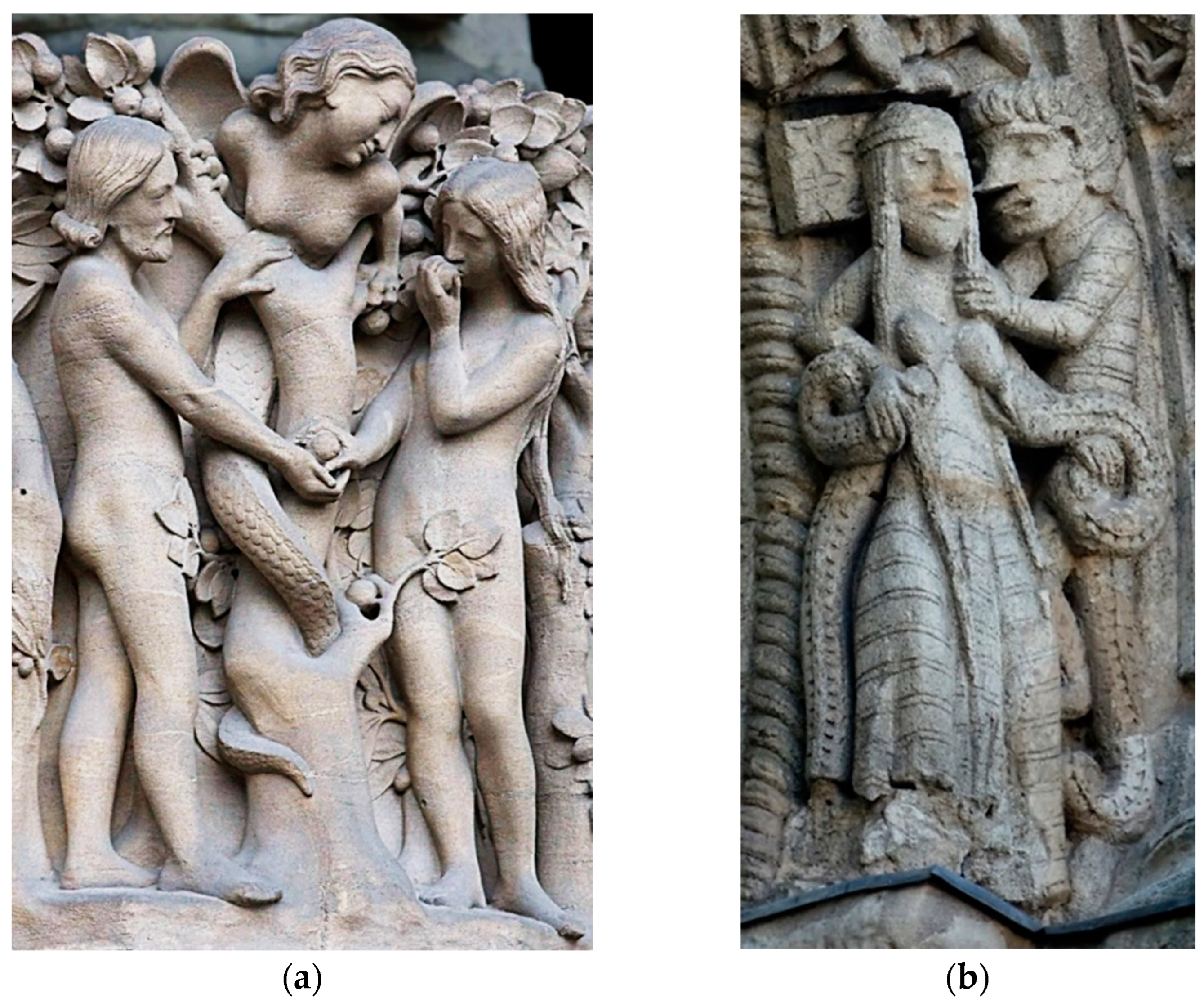
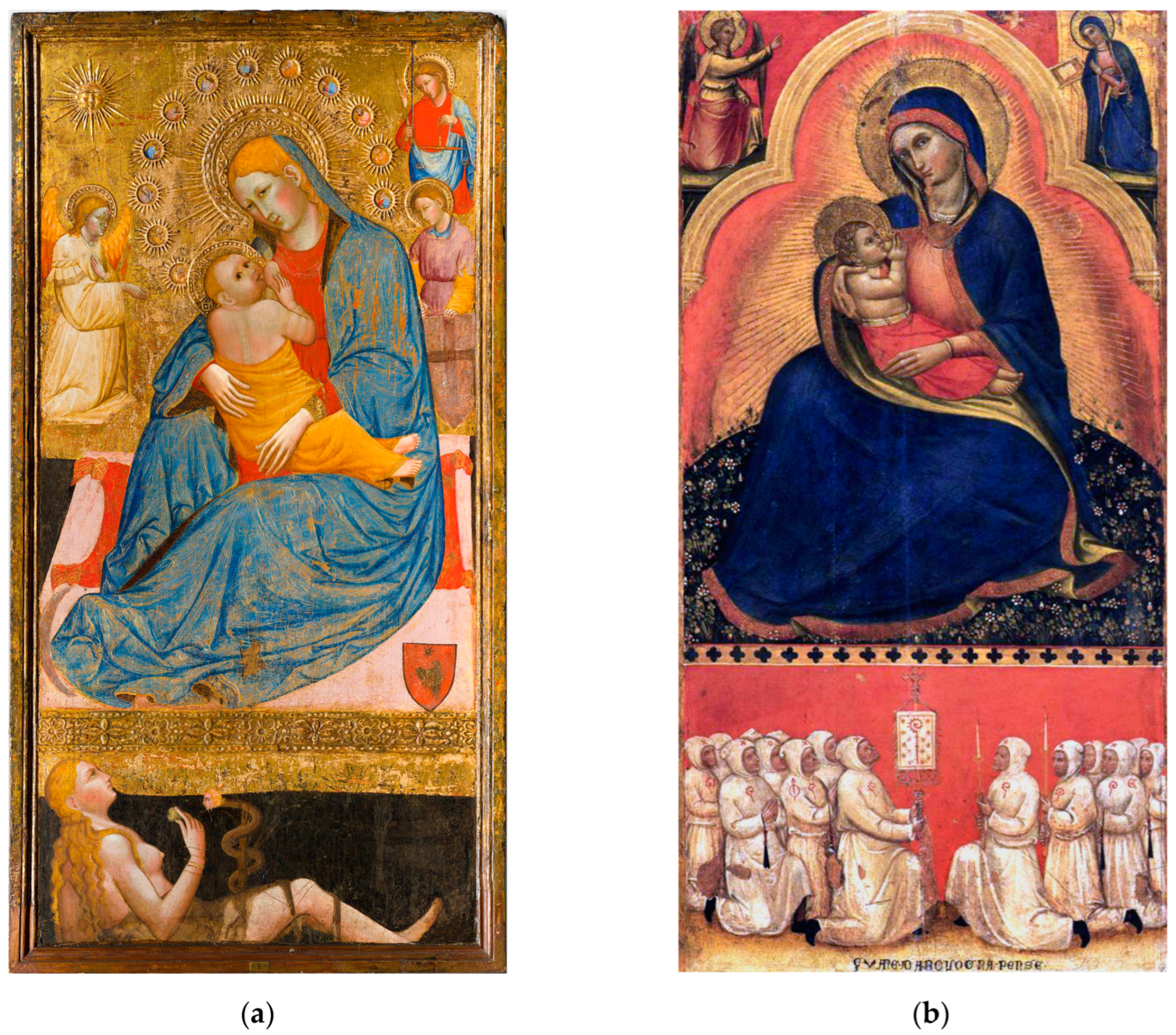
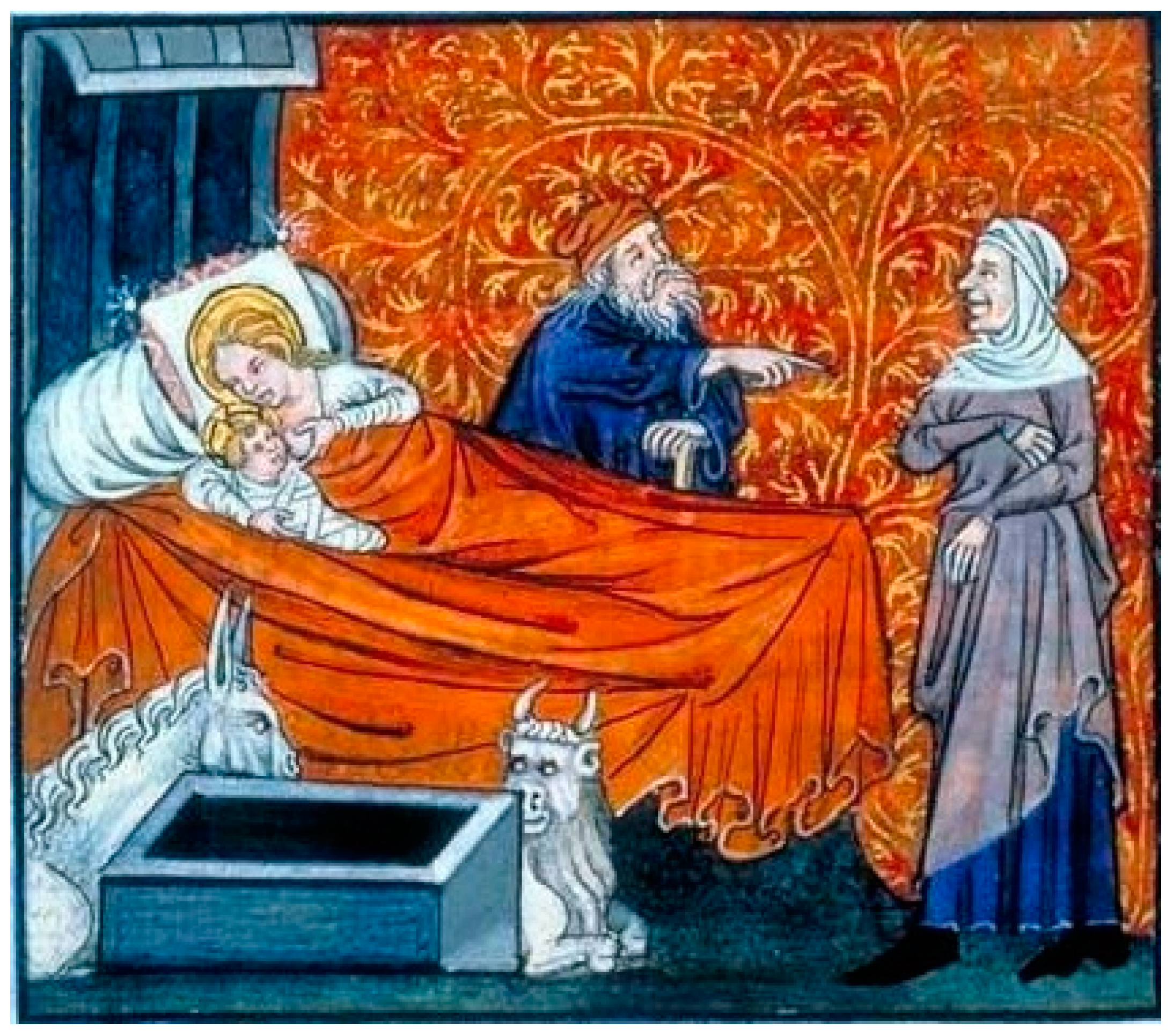
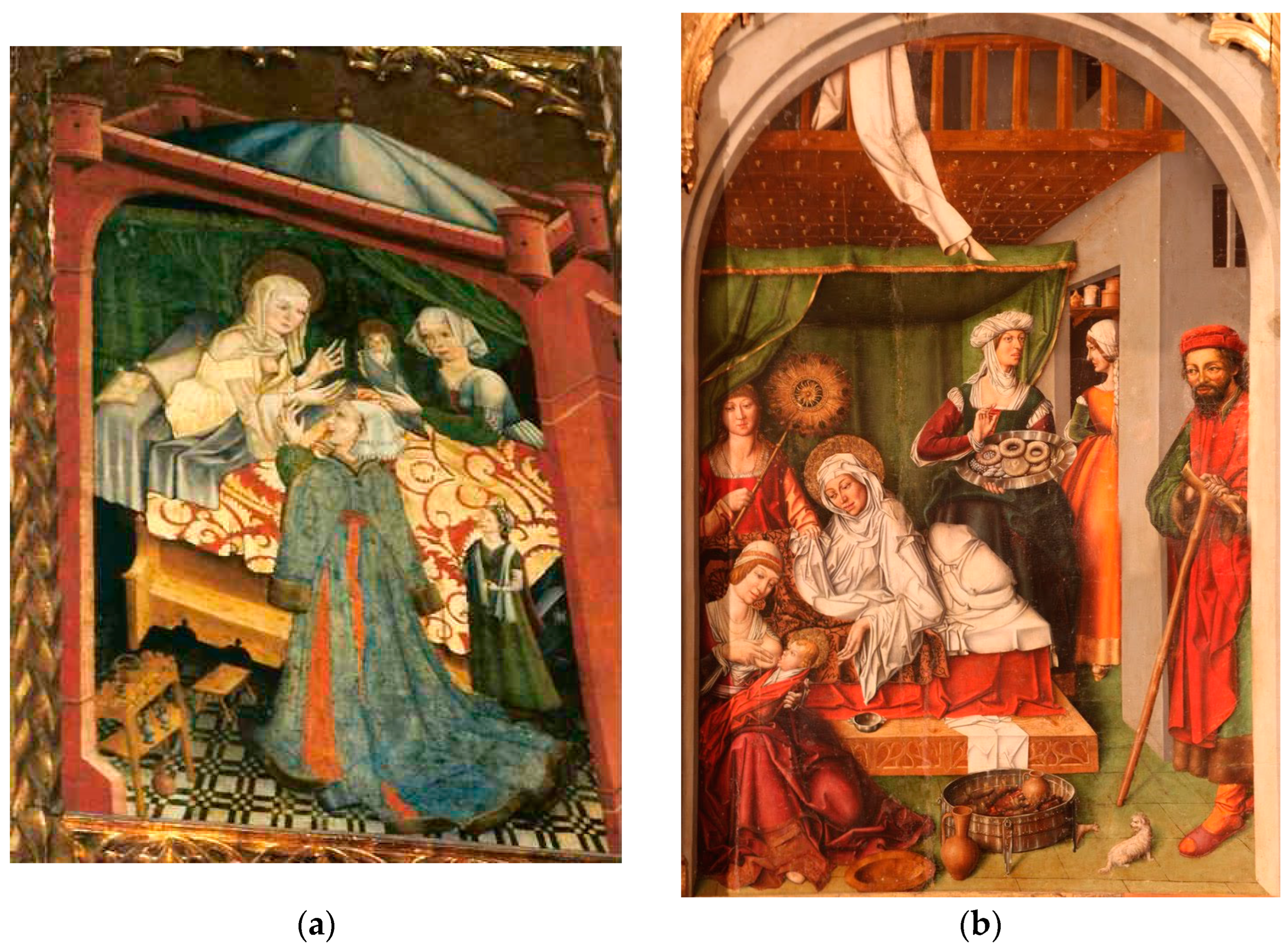
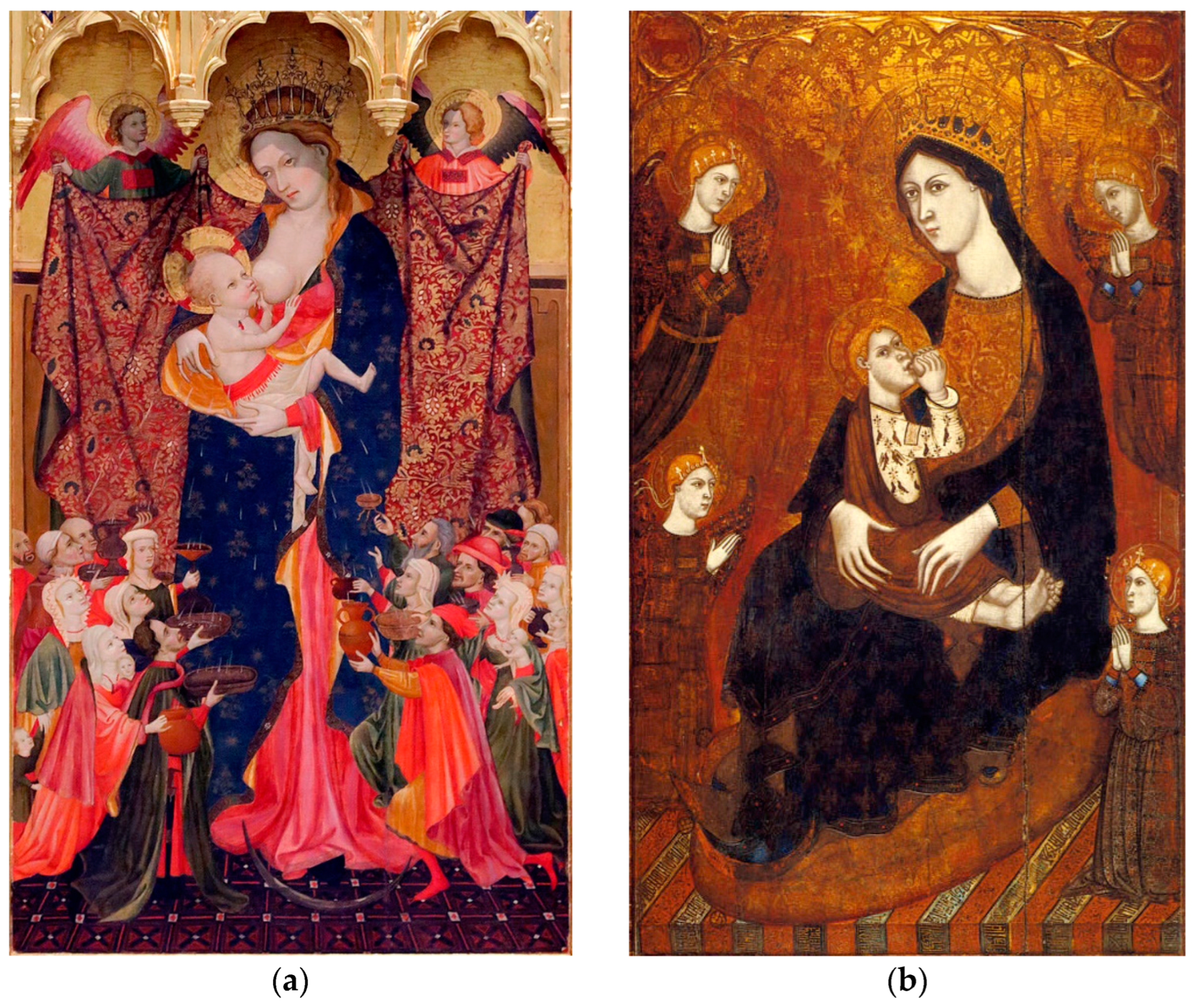
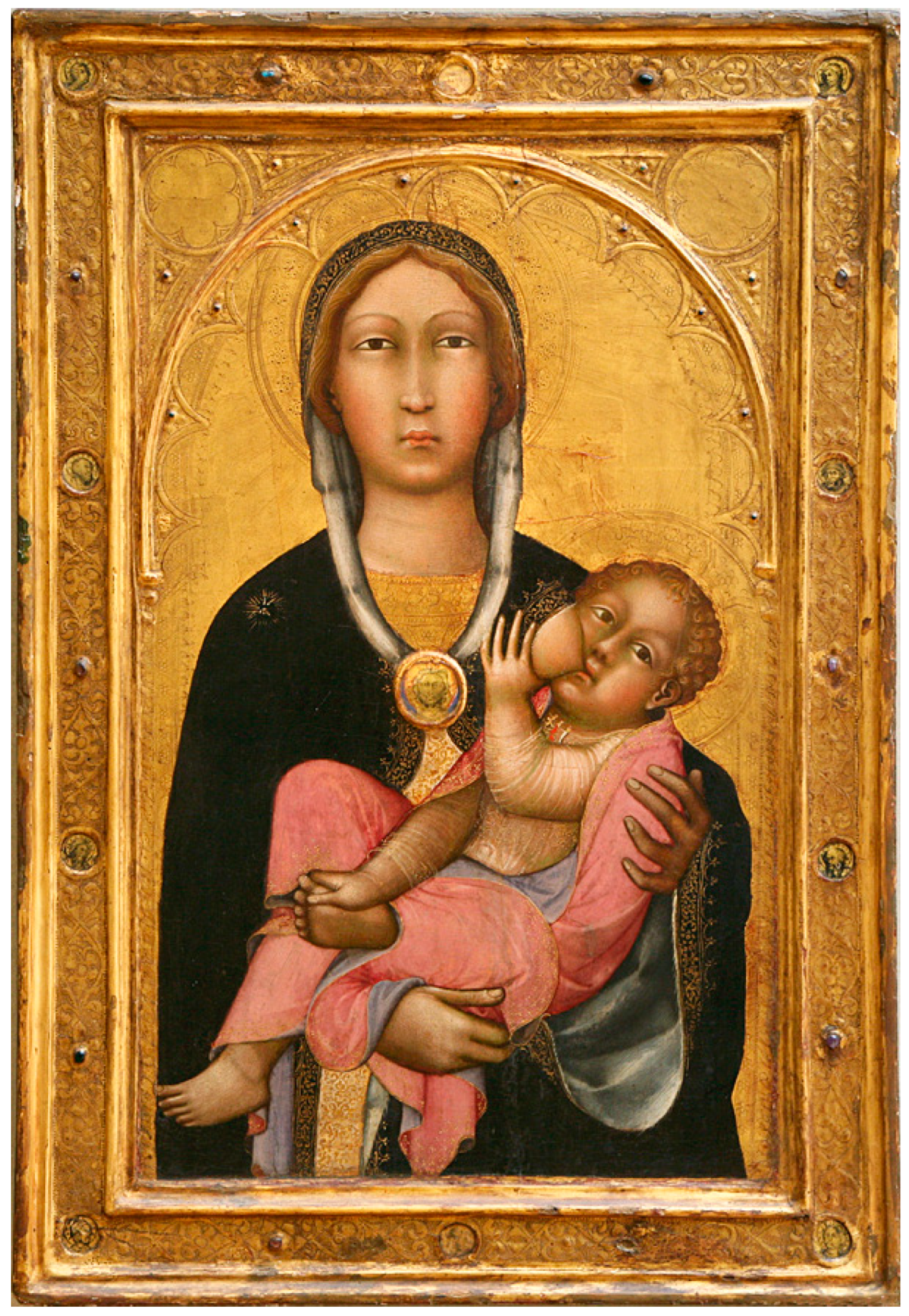
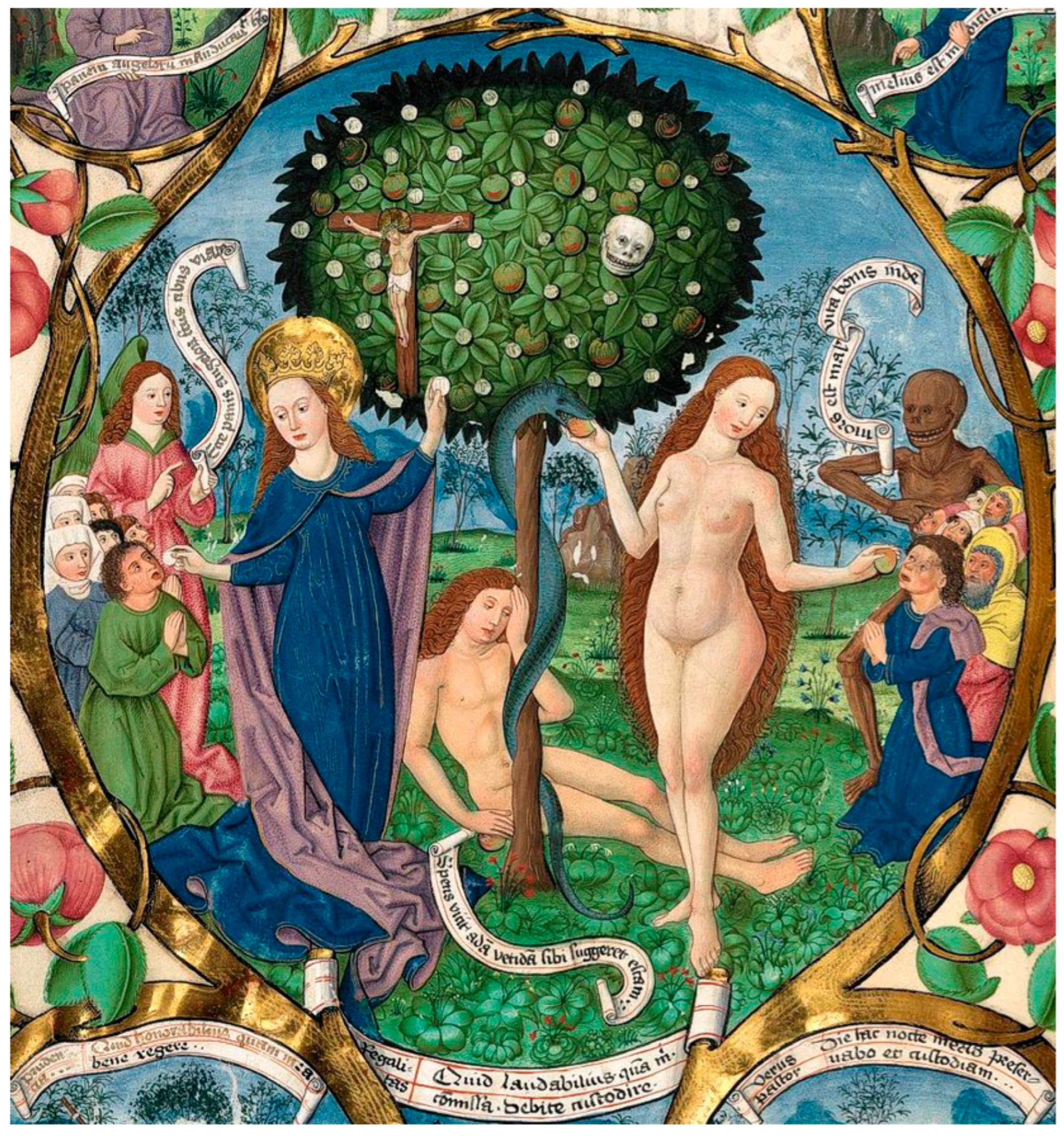
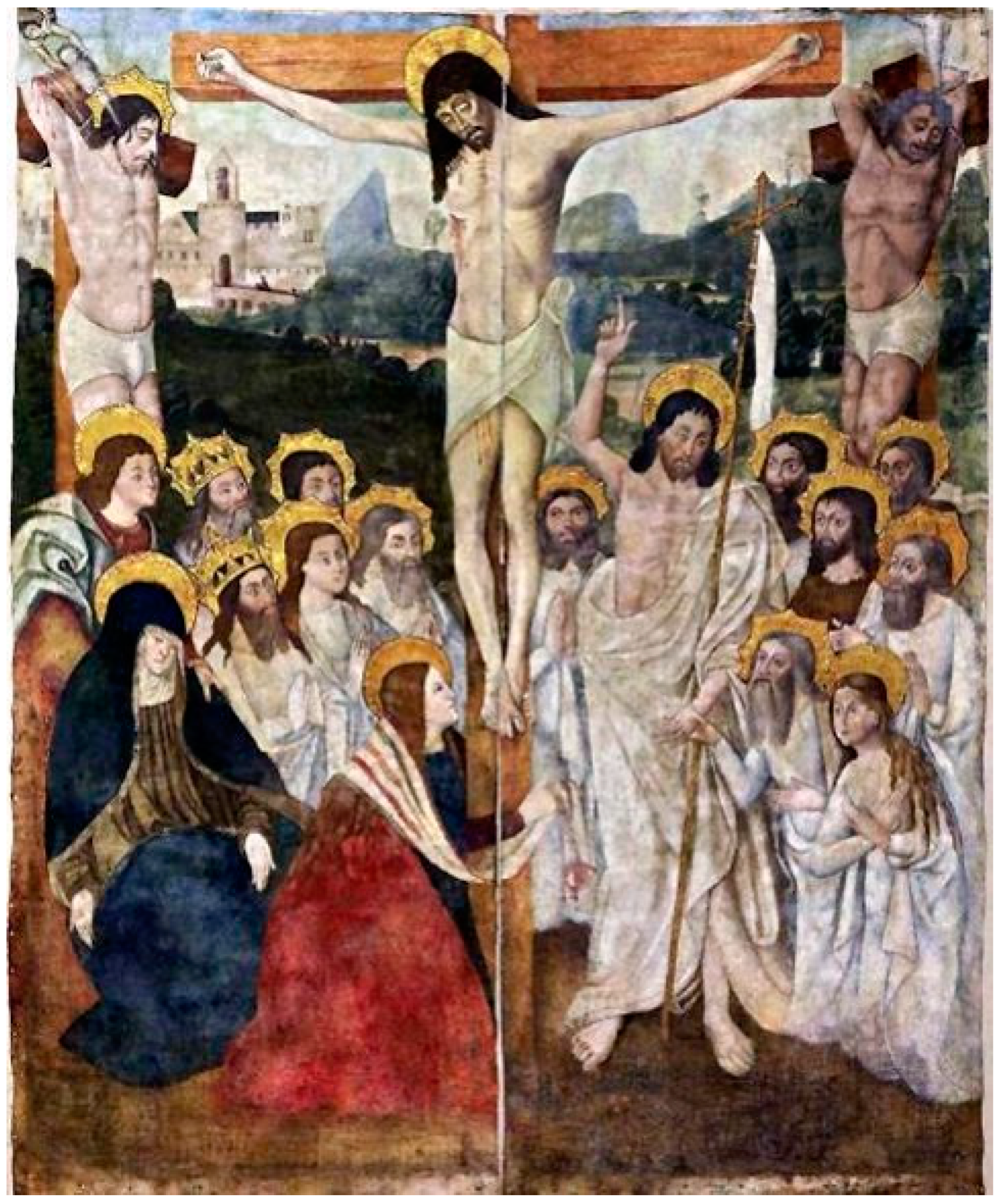
Disclaimer/Publisher’s Note: The statements, opinions and data contained in all publications are solely those of the individual author(s) and contributor(s) and not of MDPI and/or the editor(s). MDPI and/or the editor(s) disclaim responsibility for any injury to people or property resulting from any ideas, methods, instructions or products referred to in the content. |
© 2023 by the author. Licensee MDPI, Basel, Switzerland. This article is an open access article distributed under the terms and conditions of the Creative Commons Attribution (CC BY) license (https://creativecommons.org/licenses/by/4.0/).
Share and Cite
Mocholí Martínez, M.E. The Nursing Madonna in the Middle Ages: An Interdisciplinary Study. Religions 2023, 14, 568. https://doi.org/10.3390/rel14050568
Mocholí Martínez ME. The Nursing Madonna in the Middle Ages: An Interdisciplinary Study. Religions. 2023; 14(5):568. https://doi.org/10.3390/rel14050568
Chicago/Turabian StyleMocholí Martínez, María Elvira. 2023. "The Nursing Madonna in the Middle Ages: An Interdisciplinary Study" Religions 14, no. 5: 568. https://doi.org/10.3390/rel14050568
APA StyleMocholí Martínez, M. E. (2023). The Nursing Madonna in the Middle Ages: An Interdisciplinary Study. Religions, 14(5), 568. https://doi.org/10.3390/rel14050568





